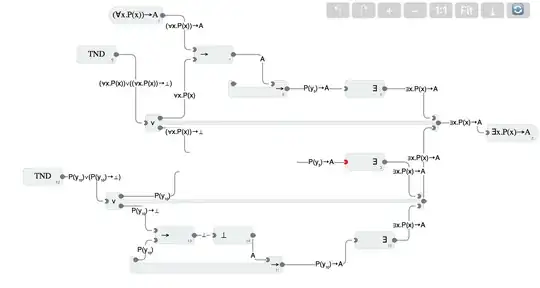Update: Updated the title now that I've observed that we can use math in the title. I've also gone thru and removed dots. The tool expresses quantification using dots like this $\forall x.P(x)$ rather than $\forall x P(x)$. I originally used these dots in my post as well.
I'm going through all of the proofs in The Incredible Proof Machine and need a hint for one of the proofs. (The Incredible Proof Machine is an online graphical proof tool.)
Given: $(\forall x P(x)) \to A $
Prove: $\exists x (P(x) \to A )$
It seems like a trivial proof and here's my hand-waving attempt: There are two cases to consider:
- $\forall(x) P(x)$: In this case its trivial to prove the conclusion since we can prove $A$.
- $\neg \forall(x) P(x) $ In this case it must be that there exists some $c$ such that $ \neg P(c)$. Therefore trivially, $P(c) \to A$ and therefore $\exists x (P(x) \to A)$.
However, I get stuck trying to prove it using the actual logic connectors available in the tool. I'm not able to use the same approach in the second case of my case analysis (or at least I'm not sure how). This is my attempt:
If you look right in the middle of the diagram you'll see there are no connections (and a small red dot indicating an error). This approach doesn't seem to lead anywhere.
I'm using two instances of TND to do case analysis. The first case is as described above. But I don't know how to handle the second case, so I used a TND in the second case to generate two sub-cases: $P(y_{10}) \vee (P(y_{10}) \to \bot)$. The second case of this TND is again trivial, but the first case doesn't lead anywhere.
In the middle of the proof I have two facts $P(y_{10})$ and $(\forall x P(X)) \to \bot$. These two facts don't seem like they can lead to the conclusion.
I'm looking for a hint of an approach to try to solve this proof.

